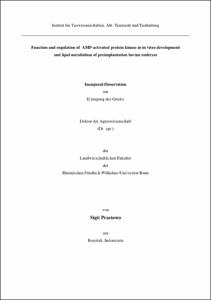Prastowo, Sigit: Function and regulation of AMP-activated protein kinase in in vitro development and lipid metabolism of preimplantation bovine embryos. - Bonn, 2015. - Dissertation, Rheinische Friedrich-Wilhelms-Universität Bonn.
Online-Ausgabe in bonndoc: https://nbn-resolving.org/urn:nbn:de:hbz:5n-40640
Online-Ausgabe in bonndoc: https://nbn-resolving.org/urn:nbn:de:hbz:5n-40640
@phdthesis{handle:20.500.11811/6252,
urn: https://nbn-resolving.org/urn:nbn:de:hbz:5n-40640,
author = {{Sigit Prastowo}},
title = {Function and regulation of AMP-activated protein kinase in in vitro development and lipid metabolism of preimplantation bovine embryos},
school = {Rheinische Friedrich-Wilhelms-Universität Bonn},
year = 2015,
month = jul,
note = {One of the major problems associated with the in vitro production of bovine embryos is lipid accumulation due to the presence of serum in culture media. AMP-activated protein kinase (AMPK) is well documented as a master regulator of energy metabolism, particularly lipid metabolism, in mammalian cells. The present study aimed to explore the potential role of the AMPK pathway in bovine embryos related to lipid accumulation. For this, the whole study was divided into 3 experiments. In experiment 1, the AMPK activity of in vitro produced blastocysts in the presence or absence of serum was analyzed and associated with lipid metabolism phenotypes. In experiment 2, 5-aminoimidazole-4-carboxamide riboside (AICAR) was applied to enhance AMPK activity during in vitro culture, to investigate its effect on embryo development rate, blastocyst cell number, AMPK activity, mitochondrial activity and the expression of lipid metabolism genes. Furthermore in experiment 3, the post transcriptional regulatory mechanism of AMPKA1 gene was investigated in bovine granulosa cells. The results showed that the presence of serum suppressed the expression of genes in the AMPK pathway (AMPKA1, STK11) and mitochondrial activity (CPT1, PGC1A), while the expression of lipid synthesis gene (ACC) was significantly increased. In addition to the reduced activity of AMPK, the presence of serum increased the level of ROS accumulation followed by low mitochondrial activity in resulting blastocysts. The application of AICAR during embryo culture showed no impact on embryo development rate but significantly reduced blastocyst cell number. The presence of AICAR increased the expression AMPKA1, STK11, CPT2, PGC1A, NQO1 genes, while ACC was suppressed. In experiment 3, in silico study predicted 11 miRNAs as potential regulators of AMPKA1. The miRNA profiling in granulosa cells showed that miR-33b is the most abundant miRNA accompanied by low expression of AMPKA1 and high lipid droplet accumulation. Luciferase assay validated the binding of miR-33b and the 3’UTR of AMPKA1. Inhibition of miR-33b resulted in up regulation of AMPKA1 and significantly increases PGC1A gene expression. Moreover, miR-33b was highly expressed in blastocysts derived from culture with serum, while AMPKA1 showed a reverse pattern compared to without serum. Altogether, the present study demonstrates that expression of AMPK and lipid metabolism pathway in blastocysts were affected by the presence of serum in culture media leading to accumulation of lipid.},
url = {https://hdl.handle.net/20.500.11811/6252}
}
urn: https://nbn-resolving.org/urn:nbn:de:hbz:5n-40640,
author = {{Sigit Prastowo}},
title = {Function and regulation of AMP-activated protein kinase in in vitro development and lipid metabolism of preimplantation bovine embryos},
school = {Rheinische Friedrich-Wilhelms-Universität Bonn},
year = 2015,
month = jul,
note = {One of the major problems associated with the in vitro production of bovine embryos is lipid accumulation due to the presence of serum in culture media. AMP-activated protein kinase (AMPK) is well documented as a master regulator of energy metabolism, particularly lipid metabolism, in mammalian cells. The present study aimed to explore the potential role of the AMPK pathway in bovine embryos related to lipid accumulation. For this, the whole study was divided into 3 experiments. In experiment 1, the AMPK activity of in vitro produced blastocysts in the presence or absence of serum was analyzed and associated with lipid metabolism phenotypes. In experiment 2, 5-aminoimidazole-4-carboxamide riboside (AICAR) was applied to enhance AMPK activity during in vitro culture, to investigate its effect on embryo development rate, blastocyst cell number, AMPK activity, mitochondrial activity and the expression of lipid metabolism genes. Furthermore in experiment 3, the post transcriptional regulatory mechanism of AMPKA1 gene was investigated in bovine granulosa cells. The results showed that the presence of serum suppressed the expression of genes in the AMPK pathway (AMPKA1, STK11) and mitochondrial activity (CPT1, PGC1A), while the expression of lipid synthesis gene (ACC) was significantly increased. In addition to the reduced activity of AMPK, the presence of serum increased the level of ROS accumulation followed by low mitochondrial activity in resulting blastocysts. The application of AICAR during embryo culture showed no impact on embryo development rate but significantly reduced blastocyst cell number. The presence of AICAR increased the expression AMPKA1, STK11, CPT2, PGC1A, NQO1 genes, while ACC was suppressed. In experiment 3, in silico study predicted 11 miRNAs as potential regulators of AMPKA1. The miRNA profiling in granulosa cells showed that miR-33b is the most abundant miRNA accompanied by low expression of AMPKA1 and high lipid droplet accumulation. Luciferase assay validated the binding of miR-33b and the 3’UTR of AMPKA1. Inhibition of miR-33b resulted in up regulation of AMPKA1 and significantly increases PGC1A gene expression. Moreover, miR-33b was highly expressed in blastocysts derived from culture with serum, while AMPKA1 showed a reverse pattern compared to without serum. Altogether, the present study demonstrates that expression of AMPK and lipid metabolism pathway in blastocysts were affected by the presence of serum in culture media leading to accumulation of lipid.},
url = {https://hdl.handle.net/20.500.11811/6252}
}






